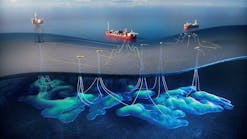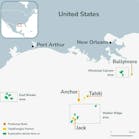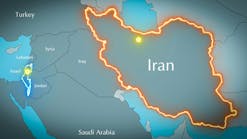With David Knott
from London
Lightning is not supposed to strike the same place twice, but the U.K.'s latest oil spill has shown that tankers can.
On Feb. 15 the 147,000 metric ton Sea Empress hit rocks at the mouth of the estuary leading to Milford Haven harbor, South Wales, in bad weather.
Only last October the Borga tanker hit the same rocks after its steering failed in good weather (OGJ, Nov. 6, 1995, p. 22).
And in defiance of laws of probability, Sea Empress was hauled off the rocks Feb. 16, only to run aground on nearby sand next day in high winds and again in the same spot Feb. 19 due to an unexpectedly low tide.
Sea Empress, a single hull tanker built in 1993, was carrying 130,000 metric tons of crude oil bound for Texaco Ltd.'s Pembroke refinery.
Press reports said 70,000 metric tons of oil had spilled into the water from the vessel. Borga was a double hull tanker and lost no oil.
Human error
A spokesman for Acomarit (U.K.) Ltd., Glasgow, operator of the Sea Empress, said early reports suggested the tanker's steering had failed. But later investigation by Acomarit suggested human error as the cause.
The estuary entrance is notoriously difficult for large tankers to transit in rough weather. Timing and positioning of vessels are crucial, with pilots having only 15 min to get tow ropes secured before maneuvering.
An official at the Department of Transport's Marine Pollution Control Unit (MPCU) said a salvage team boarded Sea Empress Feb. 19.
The salvors planned to get the ship's generators and boilers working and prepare to pump remaining oil into another tanker.
The MPCU official said spilled oil was being washed ashore-"not as much as you might think from TV coverage"-and much of the oil was being broken up by the tide and by dispersant spraying.
A spokesman for environmental campaign group Friends of the Earth (FoE) said the Sea Empress grounding raised a number of issues.
"First, there is the question of whether there were sufficient tugs in the area to deal with a stricken tanker," the spokesman said. There were delays Feb. 16 as salvors awaited arrival of a large tug from Southampton.
Prevention
"The oil industry also should place greater emphasis on use of double hull tankers," the FoE spokesman said. "The Borga did not lose any oil, and a double hull might have prevented a spill here. However, the obvious thing is to stop tankers getting onto rocks in the first place."
Milford Haven harbor masters should think about sending tugs out into open water to meet tankers, the FoE official said. Also, there is concern about the size of tankers delivering oil to the area's refineries.
The FoE spokesman said, "When the refineries were built, the harbor authorities envisaged tankers of up to 100,000 metric tons delivering oil. Now we have tankers up to 150,000 metric tons arriving."
Ed Ball, director of London's Oil Companies International Marine Forum, said the International Maritime Organization (IMO) legislated for adoption of double hull tankers but cannot legislate for quick adoption.
Ball said, "The tanker industry has spent lots of time addressing the mechanics and regulations of tanker safety, but it is up to people to apply them."
Copyright 1996 Oil & Gas Journal. All Rights Reserved.


